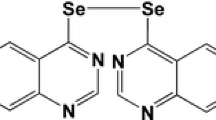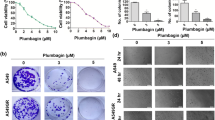Abstract
Recent studies have shown that arsenic trioxide (ATO) is an effective anti-cancer drug for treatment of acute promyelocytic leukemia and other types of human cancer. However, we have found that lung cancer cells constantly develop a high level of resistance to ATO. In this study, we have explored a possibility of combination of dihydroartemisinin (DHA) and ATO treatments to reduce ATO resistance of lung cancer cells. We determined the combinatory effects of DHA and ATO on cytotoxicity of human lung adenocarcinoma (A549) cells. We showed that co-exposure to DHA and ATO of A549 cells synergistically increased the cytotoxicity and apoptotic cell death in the cells. We found that the synergistic effect of DHA and ATO in promoting apoptosis mainly resulted from increased cellular level of reactive oxygen species (ROS) and DNA damage. ATO alone only exerted moderate growth inhibitory effects on A549 cells. The results indicate that DHA can significantly sensitize ATO-induced cytotoxicity of A549 lung cancer cells through apoptosis mediated by ROS-induced DNA damage. Interestingly, we found that the combinatory treatment of DHA and ATO did not result in significant adverse effects in normal human bronchial epithelial (HBE) cells. Our results further provide evidence for the potential application of combinatory effects of DHA and ATO as a safe therapy for human lung cancer.







Similar content being viewed by others
References
Luo Q, Lai Y, Liu S, Wu M, Liu Y, Zhang Z (2012) Deregulated expression of DNA polymerase β is involved in the progression of genomic instability. Environ Mol Mutagen 53(5):325–333
Zhang TD, Chen GQ, Wang ZG, Wang ZY, Chen SJ, Chen Z (2001) Arsenic trioxide, a therapeutic agent for APL. Oncogene 20(49):7146–7153
Dogra S, Bandi S, Viswanathan P, Gupta S (2014) Arsenic trioxide amplifies cisplatin toxicity in human tubular cells transformed by HPV-16 E6/E7 for further therapeutic directions in renal cell carcinoma. Cancer Lett 356(2):953–961
Ji H, Li Y, Jiang F, Wang X, Zhang J, Shen J, Yang X (2014) Inhibition of transforming growth factor beta/SMAD signal by MiR-155 is involved in arsenic trioxide-induced anti-angiogenesis in prostate cancer. Cancer Sci 105(12):1541–1549
Wang X, Jiang F, Mu J, Ye X, Si L, Ning S, Li Z, Li Y (2014) Arsenic trioxide attenuates the invasion potential of human liver cancer cells through the demethylation-activated microRNA-491. Toxicol Lett 227(2):75–83
Jiang X, Chen C, Zhao W, Zhang Z (2013) Sodium arsenite and arsenic trioxide differently affect the oxidative stress, genotoxicity and apoptosis in A549 cells: an implication for the paradoxical mechanism. Environ Toxicol Pharmacol 36(3):891–902
Walker AM, Stevens JJ, Ndebele K, Tchounwou PB (2016) Evaluation of arsenic trioxide potential for lung cancer treatment: assessment of apoptotic mechanisms and oxidative damage. J Cancer Sci Ther 8(1):1–9
Yang C, Kuo M, Chen J, Chen Y (1999) Arsenic trioxide sensitivity is associated with low level of glutathione in cancer cells. Br J Cancer 81(5):796–799
Fan XY, Chen XY, Liu YJ, Zhong HM, Jiang FL, Liu Y (2016) Oxidative stress-mediated intrinsic apoptosis in human promyelocytic leukemia HL-60 cells induced by organic arsenicals. Sci Rep 6:29865
Varghese MV, Abhilash M, Paul MV, Alex M, Nair RH (2016) Omega-3 fatty acid protects against arsenic trioxide-induced cardiotoxicity in vitro and in vivo. Cardiovasc Toxicol. doi:10.1007/s12012-016-9361-3
Barbey JT, Pezzullo JC, Soignet SL (2003) Effect of arsenic trioxide on QT interval in patients with advanced malignancies. J Clin Oncol 21(19):3609–3615
Hao L, Zhao J, Wang X, Wang H, Wang H, Xu G (2013) Hepatotoxicity from arsenic trioxide for pediatric acute promyelocytic leukemia. J Pediatr Hematol Oncol 35(2):e67–e70
Vuky J, Yu R, Schwartz L, Motzer RJ (2002) Phase II trial of arsenic trioxide in patients with metastatic renal cell carcinoma. Investig New Drugs 20(3):327–330
Westervelt P, Brown RA, Adkins DR, Khoury H, Curtin P, Hurd D, Luger SM, Ma MK, Ley TJ, Di Persio JF (2001) Sudden death among patients with acute promyelocytic leukemia treated with arsenic trioxide. Blood 98(2):266–271
Song J, Zhao Z, Fan X, Chen M, Cheng X, Zhang D, Wu F, Ying X, Ji J (2016) Shikonin potentiates the effect of arsenic trioxide against human hepatocellular carcinoma in vitro and in vivo. Oncotarget. doi:10.18632/oncotarget.12041
Huang HL, Chao MW, Li YC, Chang LH, Chen CH, Chen MC, Cheng CC, Liou JP, Teng CM, Pan SL (2016) MPT0G066, a novel anti-mitotic drug, induces JNK-independent mitotic arrest, JKN-mediated apoptosis, and potentiates antineoplastic effect of cisplatin in ovarian cancer. Sci Rep 6:31664
Sriram D, Rao VS, Chandrasekhara KV, Yogeeswari P (2004) Progress in the research of artemisinin and its analogues as antimalarials: an update. Nat Prod Res 18(6):503–527
Dhingra V, Vishweshwar Rao K, Lakshmi Narasu M (2000) Current status of artemisinin and its derivatives as antimalarial drugs. Life Sci 66(4):279–300
Wang SJ, Gao Y, Chen H, Kong R, Jiang HC, Pan SH, Xue DB, Bai XW, Sun B (2010) Dihydroartemisinin inactivates NF-kB and potentiates the anti-tumor effect of gemcitabine on pancreatic cancer both in vitro and in vivo. Cancer Lett 293(1):99–108
Ji Y, Zhang YC, Pei LB, Shi LL, Yan JL, Ma XH (2011) Anti-tumor effects of dihydroartemisinin on human osteosarcoma. Mol Cell Biochem 351(1–2):99–108
Gao X, Luo Z, Xiang T, Wang K, Li J, Wang P (2011) Dihydroartemisinin induces endoplasmic reticulum stress-mediated apoptosis in HepG2 human hepatoma cells. Tumori 97(6):771–780
Lai H, Singh NP (1995) Selective cancer cell cytotoxicity from exposure to dihydroartemisinin and holotransferrin. Cancer Lett 91(1):41–46
Lai H, Sasaki T, Singh NP, Messay A (2005) Effects of artemisinin-tagged holotransferrin on cancer cells. Life Sci 76(11):1267–1279
Chen T, Li M, Zhang RW, Wang H (2009) Dihydroartemisinin induces apoptosis and sensitizes human ovarian cancer cells to carboplatin therapy. J Cell Mol Med 13(7):1358–1370
Zhao C, Gao W, Chen T (2014) Synergistic induction of apoptosis in A549 cells by hidydroartemisinin and gemcitabine. Apoptosis 19(4):668–681
Zhao C, Qin G, Gao W, Chen J, Liu H, Xi G, Li T, Wu S, Chen T (2014) Potent proapoptotic actions of dihydroartemisinin in gemcitabine-resistant A549 cells. Cell Signal 26(10):2223–2233
Miller WH, Schipper HM, Lee JS, Singer J, Waxman S (2002) Mechanisms of action of arsenic trioxide. Cancer Res 62(14):3893–3903
Evens AM, Tallman MS, Gartenhaus RB (2004) The potential of arsenic trioxide in the treatment of malignant disease: past, present, and future. Leuk Res 28(9):891–900
Cui X, Kobayashi Y, Akashi M, Okayasu R (2008) Metabolism and the paradoxical effects of arsenic: carcinogenesis and anticancer. Curr Med Chem 15(22):2293–2304
Flora SJ (2011) Arsenic-induced oxidative stress and its reversibility. Free Radic Biol Med 51(2):257–281
Lai H, Singh NP, Sasaki T (2013) Development of artemisinin compounds for cancer treatment. Investig New Drugs 31(1):230–246
Dell’Eva R, Pfeffer U, Vene R, Anfosso L, Forlani A, Albini A, Efferth T (2004) Inhibition of angiogenesis in vivo and growth of Kaposi’s sarcoma xenograft tumors by the anti-malarial artesunate. Biochem Pharmacol 68(12):2359–2366
Disbrow GL, Baege AC, Kierpiec KA, Yuan H, Centeno JA, Thibodeaux CA, Hartmann D, Schlegel R (2005) Dihydroartemisinin is cytotoxic to papillomavirus-expressing epithelial cells in vitro and in vivo. Cancer Res 65(23):10854–10861
Singh NP, Lai H (2004) Artemisinin induces apoptosis in human cancer cells. Anticancer Res 24(4):2277–2280
Lee J, Zhou HJ, Wu XH (2006) Dihydroartemisinin down regulates vascular endothelial growth factor expression and induces apoptosis in chronic myeloid leukemia K562 cells. Cancer Chemoth Pharm 57(2):213–220
Mercer AE, Maggs JL, Sun XM, Cohen GM, Chadwick J, O’Neill PM, Park BK (2007) Evidence for the involvement of carbon-centered radicals in the induction of apoptotic cell death by artemisinin compounds. J Biol Chem 282(13):9372–9382
Gu S, Chen C, Jiang X, Zhang Z (2016) ROS-mediated endoplasmic stress and mitochondrial dysfunction underlie apoptosis induced by resveratrol and arsenic trioxide in A549 cells. Chem Biol Interact 245:100–109
Yedjou C, Tchounwou P, Jenkins J, McMurray R (2010) Basic mechanisms of arsenic trioxide (ATO)-induced apoptosis in human leukemia (HL-60) cells. J Hematol Oncol 3:28. doi:10.1186/1756-8722-3-28
Qin G, Zhao C, Zhang L, Liu H, Quan Y, Chai L, Wu S, Wang X, Chen T (2015) Dihydroartemisinin induces apoptosis preferentially via a Bim-mediated intrinsic pathway in hepatocarcinoma cells. Apoptosis 20(8):1072–1086
Liao K, Li J, Wang Z (2014) Dihydroartemisinin inhibits cell proliferation via AKT/GSK3β/cyclinD1 pathway and induces apoptosis in A549 lung cancer cells. Int J Clin Exp Pathol 7(12):8684–8691
Wylie PG, Bowen WP (2007) Determination of cell colony formation in a high content screening assay. Clin Lab Med 27(1):193–199
Tice RR, Agurell E, Anderson D, Burlinson B, Hartmann A, Kobayashi H, Miyamae Y, Rojas E, Ryu JC, Sasaki YF (2000) Single cell gel/comet assay: guidelines for in vitro and in vivo genetic toxicology testing. Environ Mol Mutagen 35(3):206–221
Takeshita H, Gebhardt MC, Springfield DS, Kusuzaki K, Mankin HJ (1996) Experimental models for the study of drug resistance in osteosarcoma: P-glycoprotein-positive, murine osteosarcoma cell lines. J Bone Joint Surg Am 78(3):366–375
Wang B, Hou D, Liu Q, Wu T, Guo H, Zhang X, Zou Y, Liu Z, Liu J, Wei J, Gong Y, Shao C (2015) Artesunate sensitizes ovarian cancer cells to cisplatin by downregulating RAD51. Cancer Biol Ther 16(10):1548–1556
Lai H, Singh NP (2001) Selective toxicity of dihydroartemisinin and holotransferrin toward human breast cancer cells. Life Sci 70:49–56
Emadi A, Gore SD (2010) Arsenic trioxide—an old drug rediscovered. Blood Rev 24(4–5):191–199
Luo Q, Li Y, Deng J, Zhang Z (2015) PARP-1 inhibitor sensitizes arsenic trioxide in hepatocellular carcinoma cells via abrogation of G 2/M checkpoint and suppression of DNA damage repair. Chem Biol Interact 226:12–22
Mei N, Lee J, Sun X, Xing JZ, Hanson J, Le XC, Weinfeld M (2003) Genetic predisposition to the cytotoxicity of arsenic: the role of DNA damage and ATM. FASEB J 17(15):2310–2312
Hei TK, Filipic M (2004) Role of oxidative damage in the genotoxicity of arsenic. Free Radic Biol Med 37(5):574–581
Yahata T, Takanashi T, Muguruma Y, Ibrahim AA, Matsuzawa H, Uno T, Sheng Y, Onizuka M, Ito M, Kato S, Ando K (2011) Accumulation of oxidative DNA damage restricts the self-renewal capacity of human hematopoietic stem cells. Blood 118(11):2941–2950
Pietenpol JA, Stewart ZA (2002) Cell cycle checkpoint signaling: cell cycle arrest versus apoptosis. Toxicology 181-182:475–481
Zhang Y, Cao EH, Qin JF (2005) Up-regulation of telomere-binding TRF1, TRF2 related to reactive oxygen species induced by As(2)O(3) in MGC-803 cells. Eur J Pharmacol 516(1):1–9
Beishline K, Azizkhan-Clifford J (2014) Interplay between the cell cycle and double-strand break response in mammalian cells. Methods Mol Biol 1170:41–59
Diaz-Moralli S, Tarrado-Castellarnau M, Miranda A, Cascante M (2013) Targeting cell cycle regulation in cancer therapy. Pharmacol Ther 138(2):255–271
Hirokawa T, Shiotani B, Shimada M, Murata K, Johmura Y, Haruta M, Tahara H, Takeyama H, Nakanishi M (2014) CBP-93872 inhibits NBS1-mediated ATR activation, abrogating maintenance of the DNA double-strand break-specific G 2 checkpoint. Cancer Res 74(14):3880–3889
Wang Q, Fan S, Eastman A, Worland PJ, Sausville EA, O’Connor PM (1996) UCN-01: a potent abrogator of G 2 checkpoint function in cancer cells with disrupted p53. J Nati Cancer Inst 88(14):956–965
Hoeijmakers JH (2001) Genome maintenance mechanisms for preventing cancer. Nature 411(6835):366–374
Roos WP, Kaina B (2006) DNA damage-induced cell death by apoptosis. Trends Mol Med 12(9):440–450
Acknowledgment
This work was supported by the grant from the National Science Foundation of China (No. 81372945) to Z. Zhang.
Author information
Authors and Affiliations
Corresponding author
Ethics declarations
Conflict of Interest
The authors declare that they have no conflict of interest.
Rights and permissions
About this article
Cite this article
Chen, H., Gu, S., Dai, H. et al. Dihydroartemisinin Sensitizes Human Lung Adenocarcinoma A549 Cells to Arsenic Trioxide via Apoptosis. Biol Trace Elem Res 179, 203–212 (2017). https://doi.org/10.1007/s12011-017-0975-5
Received:
Accepted:
Published:
Issue Date:
DOI: https://doi.org/10.1007/s12011-017-0975-5




